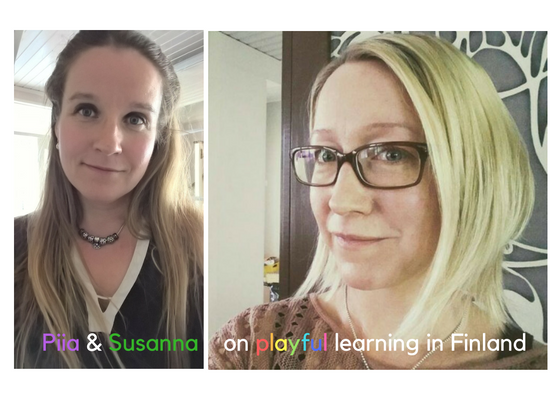Piia and Susanna are two educators from Finland and they wrote about “Playful learning in Finnish Classrooms” in the Ottiya Play Issue. Learn more about them below.
Evelyn: Please write a short bio of yourself!
Piia: I teach in Torkinmäki school in Kokkola, Finland. I teach students from ages 10 to 14. I have been classroom teacher for about 17 years and I’m also Biology/ Geography subject teacher. I’m also Microsoft Innovative Educator Expert and Global Minecraft Mentor.
Susanna: I’m a classroom teacher at Torkinmäki school in Kokkola, Finland and I’ve been working with the youngest school children (6-9 years old) for many years. I also teach the languages: German and Swedish; nowadays I perform short plays and musical performances in foreign languages in Torkinmäki.
Evelyn: As you know, the theme for the second Ottiya Magazine is play! What does play mean to you?
Piia: Playing is something fun. It’s a way to learn things without even noticing it. Playing includes social interaction where children learn everyday life in a safe environment. Or they need to negotiate their own rules while they play.
Susanna: Playing feeds one’s imagination! I think that playing is the most natural way to learn. As a teacher I want to give enough space for free play but also want to keep learning by playing as a central pedagogical tool in my classroom.
Evelyn: What was your favorite way to play as a child?
Piia: I have always loved playing different kind of board games! My absolute favorite game was (and still is) Trivial Pursuit. I wanted to win my father and the game gave me motivation to study hard in all the subjects I took at school.
Susanna: I used to love role playing with my siblings, with my cousins or with my friends. We loved playing with toys, dolls, barbies etc. When the early childhood started to end towards the teenage years, we were eager to build small cottages in the nature where we could play together following a certain theme while playing, for example “at a restaurant”, “at home/school” or “on a cruise”. Playing cards and board games was important for me, too.
Evelyn: Is there a game with a learning element that can be played anytime, anywhere? If so, can you describe the game?
Piia: In my opinion almost every game has a learning element. In mobile games like Angry Birds you need to estimate the speed and ankle for the bird. My favorite “Wordament” is kind of cross word; you need to build words from the letters. Traditional board games includes social interaction. Players need to discuss and negotiate together. On the other hand you can create your own games. My family plays a word game in the car where one says one word and the next one needs to say a word with the letter that ended the last word and so on.
Susanna: In my opinion, every child is ready for a role play, as long as he/she feels safe and is ready to accept the rules of a play. As a teacher, I should give playing a chance and go for it! It’s so much fun, giving school children a possibility to enjoy the moment, learn basic social skills and be able to use imagination. Playing can be so creative in many ways, across all school subjects.
Evelyn: Do you face challenges in introducing play in your classes? If so, how do you overcome the challenges?
Piia: I use games quite a lot in my classrooms and the students like them and are used to the games. All the games have a pedagogical perspective. By playing games my students rehearse or learn concepts. Games support communication skills, verbal skills, collaboration etc. I haven’t had any kind of challenges. On the contrary students are thrilled when they hear they can play games.
Susanna: It’s important to give enough space and time for playing. It’s my job to take care of the atmosphere and the right timing. Naturally, it’s also important to take notice of the group dynamics when putting children in pairs or in groups during the play. By getting to know the individuals in the classroom, it’s easier to vary between the pedagogical learning tools.
Evelyn: Can you give tips to teachers who would like to introduce play in their classrooms?
Piia: Give your students time to play and trust them. Even though playing sounds and feels too easy way to study it motivates students. I have listened to my students while they have played and it’s amazing to hear them talk about the themes and use the right terms and concepts just by playing games.
Susanna: By creating a playful learning environment and giving children different kinds of playing possibilities, you’ll face an eager, motivated and joyful group of children. All playing types can be part of your pedagogy but don’t hesitate to start with the ones you are most familiar with and that suit your personality and teaching style.
Recommend0 recommendationsPublished in For Parents and Teachers
